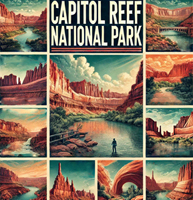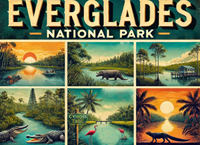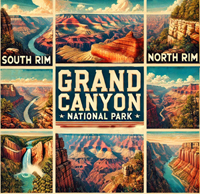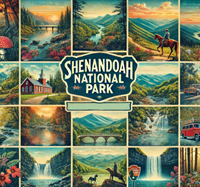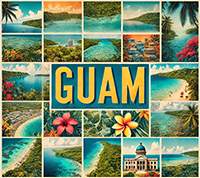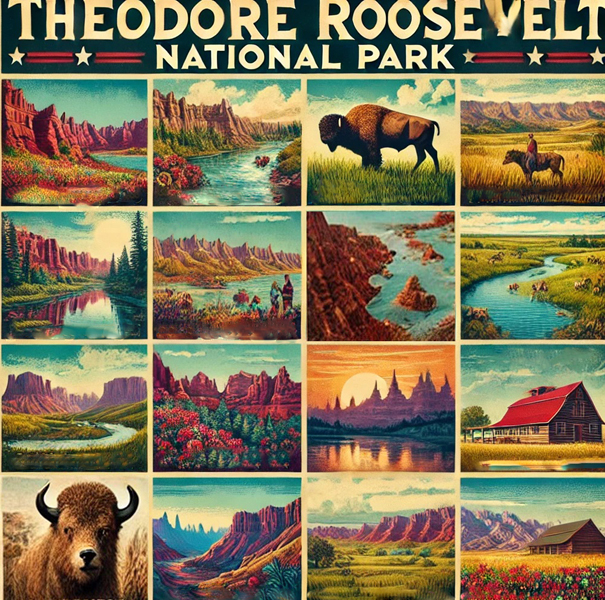
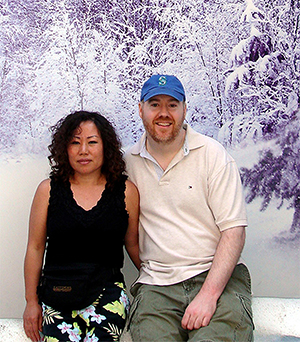
William and Hui Cha Stanek have meticulously crafted these national park guides, each showcasing the most stunning landscapes across the USA. But beyond the breathtaking scenery, these guides delve into the stories, experiences, and connections that make each park visit truly memorable.
National Parks Index | US Itineraries Index | American Roadtrips Index

Bring home a Bugville Critters book and watch as your child's love for reading and learning grows with every page. Hand-painted illustrations bring the heartwarming stories to life. Ask your librarian to add Bugville Critters to the library's digital collection today!
Discover William Stanek's Exclusive Art Collection
Explore and purchase the stunning art featured on this site. Own a piece of William Stanek's unique and captivating artwork today!
(October 29, 2024) Introducing Theodore Roosevelt National Park: North Dakota's Prairie Paradise
Introduction to Theodore Roosevelt National Park
Theodore Roosevelt National Park is a place of rugged beauty and historical significance, where the landscape of the Badlands inspired one of America' s greatest conservationists. My first visit to the park was a journey into a land shaped by wind and water, with its rolling hills, colorful buttes, and expansive grasslands. The solitude of the North Dakota Badlands gave me a sense of peace and reflection, much like it did for Theodore Roosevelt himself. One of the most memorable experiences was watching the wild horses roam freely across the plains, embodying the spirit of the American West. The park' s connection to Roosevelt' s legacy adds depth to its natural beauty, making it a place of both historical importance and stunning landscapes.
How to Reach Theodore Roosevelt National Park
From the North (Williston, ND): Travelers can take US-85 south directly to the park's North Unit entrance. The distance is approximately 120 miles, with a travel time of around 2 hours.
From the South (Bismarck, ND): Visitors from Bismarck can take Interstate 94 west to Medora, then follow signs to the park's South Unit entrance. This route covers about 130 miles and takes around 2 hours.
From the East (Fargo, ND): From Fargo, take Interstate 94 west to Medora, then follow signs to the park's South Unit entrance. This journey spans approximately 300 miles and takes around 5 hours.
From the West (Billings, MT): Travelers from Billings can take Interstate 94 east to Medora, then follow signs to the park's South Unit entrance. This route covers approximately 250 miles and takes around 4 hours.
Exploring Theodore Roosevelt: Must-Visit Sites
- Painted Canyon: Offers stunning views of the colorful badlands and is a popular spot for photography.
- Elkhorn Ranch: The site of Theodore Roosevelt's ranch, providing historical insights and scenic views.
- Petrified Forest Loop: A trail featuring fascinating petrified wood and unique geological formations.
- Wind Canyon Trail: A short hike offering panoramic views of the Little Missouri River and surrounding badlands.
Seasonal Variations
Theodore Roosevelt's prairie landscapes offer beauty in all seasons:
- Spring: Wildflowers bloom, and moderate temperatures make for ideal hiking conditions.
- Summer: Warm temperatures and clear skies provide excellent visibility and wildlife viewing opportunities.
- Fall: Cooler temperatures and vibrant fall foliage create a stunning contrast to the rugged landscape.
- Winter: Snow-covered badlands offer a serene and peaceful environment, ideal for solitude and photography.
Visitor Updates for Theodore Roosevelt National Park
Conservation Efforts
William Stanek's photography in Theodore Roosevelt National Park emphasizes the park's rugged beauty and the importance of preserving its unique ecosystems. His work supports efforts to protect the park from the impacts of climate change, development, and human activity, advocating for the conservation of its prairie landscapes and wildlife habitats.
1 Day at Theodore Roosevelt National Park: North Dakota's Badlands
Introduction
Theodore Roosevelt National Park, located in western North Dakota, is known for its rugged badlands, diverse wildlife, and historic connections to President Theodore Roosevelt. Here's a detailed guide to making the most of your visit, with expert tips from William and Hui Cha Stanek.
Morning: Sunrise and Scenic Drives
6:00 AM - Sunrise at Painted Canyon Overlook
- Overview: Start your day with a breathtaking sunrise at Painted Canyon Overlook, offering stunning views of the badlands.
- Tips from William: Arrive early to set up your tripod and capture the sunrise over the canyon. Use a wide-angle lens to encompass the entire landscape.
- Insights from Hui Cha: Dress warmly and bring a thermos of hot coffee or tea. The early morning air can be chilly.
7:30 AM - Breakfast in Medora
- Overview: Head to the nearby town of Medora for a quick breakfast at a local caf .
- Tips from William: Capture the morning light on the town's charming streets.
- Insights from Hui Cha: Enjoy a hearty breakfast to fuel your day. Grab some snacks and water for later.
Mid-Morning: Scenic Drives and Short Hikes
8:30 AM - Scenic Loop Drive
- Overview: Drive the Scenic Loop Drive, which offers some of the most spectacular views of the park.
- Tips from William: Stop frequently to capture the stunning vistas. Use a polarizing filter to reduce glare and enhance the colors of the landscape.
- Insights from Hui Cha: Take your time and enjoy the drive. The road can be narrow and winding, so drive carefully.
10:00 AM - Wind Canyon Trail
- Overview: Hike the Wind Canyon Trail, a short trail that offers stunning views of the Little Missouri River and the badlands.
- Tips from William: Use a wide-angle lens to capture the expansive views. The mid-morning light is perfect for photography.
- Insights from Hui Cha: The trail is easy and offers great photo opportunities. Wear comfortable shoes and bring a hat.
Afternoon: Prairie and Wildlife Viewing
12:00 PM - Picnic Lunch at Cottonwood Campground
- Overview: Enjoy a packed lunch at Cottonwood Campground, a beautiful spot for picnicking and relaxing.
- Tips from William: Capture candid moments of your picnic with the beautiful prairie backdrop.
- Insights from Hui Cha: Pack a nutritious and energizing meal. Take a moment to relax and enjoy the natural surroundings.
1:30 PM - Buck Hill
- Overview: Hike to the top of Buck Hill for panoramic views of the badlands and surrounding prairies.
- Tips from William: Use a wide-angle lens to capture the expansive views. The afternoon light enhances the colors of the landscape.
- Insights from Hui Cha: The hike is relatively easy and offers beautiful views. Bring water and take breaks as needed.
3:00 PM - Petrified Forest Loop
- Overview: Hike the Petrified Forest Loop to see ancient petrified wood and stunning badland formations.
- Tips from William: Use a macro lens to capture the intricate details of the petrified wood. Late afternoon light enhances the textures.
- Insights from Hui Cha: The trail is moderately strenuous, so wear sturdy hiking shoes and bring plenty of water.
Late Afternoon: Photography and Relaxation
4:30 PM - Peaceful Valley Ranch
- Overview: Visit the historic Peaceful Valley Ranch, which offers insights into the park's history and landscape.
- Tips from William: Use a wide-angle lens to capture the historic buildings and surrounding scenery. Experiment with different compositions and perspectives.
- Insights from Hui Cha: This is a perfect spot to relax and take in the scenery. Bring a snack and enjoy the view.
Evening: Sunset and Dinner
6:00 PM - Sunset at Boicourt Overlook
- Overview: Head to Boicourt Overlook for a stunning sunset view over the badlands.
- Tips from William: Use a graduated neutral density filter to balance the exposure. Experiment with long exposures to capture the changing light.
- Insights from Hui Cha: Arrive early to find a good spot. Bring a light jacket as it can get cool after sunset.
7:30 PM - Dinner in Medora
- Overview: Return to Medora for a relaxing dinner at a local restaurant.
- Tips from William: Capture the evening atmosphere of the small town. Try some local North Dakota cuisine to end your day.
- Insights from Hui Cha: Reflect on the day's adventures and enjoy a hearty meal. Medora offers a variety of dining options with a welcoming atmosphere.
Theodore Roosevelt National Park (North Dakota)
Theodore Roosevelt National Park, located in western North Dakota, is named in honor of President Theodore Roosevelt, who was deeply influenced by his time in the Badlands. Covering over 70,000 acres, the park features rugged badlands, rolling prairies, and abundant wildlife, offering a tranquil and scenic destination for nature enthusiasts and history buffs.
Park History and Cultural Significance:
- Established as a national park in 1947, it honors President Theodore Roosevelt and preserves the landscapes that shaped his conservation philosophy.
- The park protects significant natural and cultural resources, including the Elkhorn Ranch site, where Roosevelt spent time reflecting and writing.
Visitor Centers and Facilities:
- South Unit Visitor Center: Located in Medora, it offers exhibits on the park's natural and cultural history, a park film, maps, information, restrooms, and a gift shop.
- North Unit Visitor Center: Provides exhibits, maps, information, restrooms, and a gift shop.
- Painted Canyon Visitor Center: Offers scenic views, exhibits, maps, information, and restrooms.
- Campgrounds: The park has several campgrounds, including Cottonwood (South Unit) and Juniper (North Unit), offering basic amenities like restrooms and picnic tables.
Best Times to Visit:
- Spring (April to May): Ideal for moderate temperatures and blooming wildflowers.
- Summer (June to August): Warm weather with daytime highs in the 80s to 90s F, perfect for exploring the park, though it can be crowded.
- Fall (September to November): Cooler temperatures and fewer crowds make this a great time to visit, with beautiful fall foliage.
- Winter (December to March): Offers solitude and opportunities for winter activities like snowshoeing and cross-country skiing, but temperatures can be cold.
Activities and Recreation:
- Hiking: Trails range from easy walks to challenging hikes, including the Wind Canyon Trail, Caprock Coulee Trail, and the Petrified Forest Loop.
- Wildlife Watching: Opportunities to see bison, elk, prairie dogs, wild horses, and a variety of bird species.
- Scenic Drives: The Scenic Loop Drive in the South Unit and the Scenic Drive in the North Unit offer breathtaking views of the park's landscapes and access to many trailheads and viewpoints.
- Camping: Campgrounds provide opportunities for both frontcountry and backcountry camping.
- Horseback Riding: The park has several equestrian trails and allows horseback riding in designated areas.
- Photography: The park's rugged badlands and diverse wildlife provide endless opportunities for photography, particularly at sunrise and sunset.
Accessibility Information:
- The South Unit, North Unit, and Painted Canyon Visitor Centers are wheelchair accessible.
- Accessible trails include the Wind Canyon Trail and the Boicourt Overlook Trail.
- Accessible campgrounds and restrooms are available throughout the park.
Permits and Regulations:
- Entrance Fees: Required for entry; passes can be purchased online or at park entrances.
- Camping Permits: Required for camping at designated campgrounds. Reservations are recommended during peak seasons.
- Backcountry Permits: Required for overnight stays in backcountry areas.
- Special Use Permits: Needed for activities such as weddings, commercial filming, and large group gatherings.
Nearby: Little Missouri National Grassland, Fort Union Trading Post National Historic Site
-
Little Missouri National Grassland: Adjacent to Theodore Roosevelt National Park, this grassland offers vast prairies, rugged terrain, and diverse wildlife.
- Activities: Hiking, wildlife viewing, camping.
- Notable Sites: Maah Daah Hey Trail, Caprock Coulee Trail.
- Wildlife: Bison, pronghorn, prairie dogs.
-
Fort Union Trading Post National Historic Site: About an hour from Theodore Roosevelt, this historic site preserves a 19th-century fur trading post.
- Activities: Historical tours, interpretive programs.
- Notable Sites: Fort Union Trading Post.
- Wildlife: Various bird species, small mammals.
Important Updates for Theodore Roosevelt National Park
Theodore Roosevelt National Park (North Dakota)
Theodore Roosevelt National Park, located in the badlands of western North Dakota, is renowned for its rugged terrain, rich wildlife, and historical significance. Named in honor of the 26th President of the United States, who was a strong advocate for conservation, the park offers stunning landscapes, abundant wildlife, and numerous opportunities for outdoor activities. Renowned photographers William and Hui Cha Stanek have captured the park's breathtaking beauty through their lenses. This guide explores local attractions, nearby towns and cities, scenic drives, and the best hikes in and around Theodore Roosevelt National Park, enriched by the Staneks' expertise and experiences.
The nearby town of Medora serves as the primary gateway to the park, offering a variety of amenities including lodging, dining, and shops. Medora is home to the Medora Musical, a popular outdoor show, and the North Dakota Cowboy Hall of Fame, which celebrates the region's cowboy culture and history.
Further afield, the city of Dickinson provides additional amenities and attractions, including the Dickinson Museum Center, which features exhibits on the region's history, geology, and paleontology. For those interested in exploring more of North Dakota's natural beauty, the Little Missouri National Grassland offers additional opportunities for hiking, wildlife viewing, and exploring the region's stunning landscapes.
Local Attractions and Surrounding Areas
Theodore Roosevelt National Park is surrounded by numerous attractions that enhance the visitor experience. Here are some must-see local attractions:
- Medora: The gateway town to the park's South Unit, Medora offers attractions such as the Medora Musical, the North Dakota Cowboy Hall of Fame, and the Chateau de Mores State Historic Site.
- Painted Canyon Visitor Center: Located off I-94, this visitor center offers exhibits and stunning views of the Painted Canyon, along with access to hiking trails.
- Elkhorn Ranch Site: The remote site of Theodore Roosevelt's cattle ranch, offering insight into his time spent in the badlands and the inspiration he drew from the landscape.
- National Buffalo Museum: Located in Jamestown, this museum offers exhibits on the history of the American bison and features a live buffalo herd.
- Maah Daah Hey Trail: An extensive trail system that winds through the badlands, offering opportunities for hiking, biking, and horseback riding.
Nearby Towns and Cities
Visitors to Theodore Roosevelt National Park can find additional amenities and activities in nearby towns and cities:
- Medora, North Dakota: The closest town to the park's South Unit, offering accommodations, dining options, and attractions such as the Medora Musical, the North Dakota Cowboy Hall of Fame, and the Chateau de Mores State Historic Site.
- Dickinson, North Dakota: Located about 30 miles east of the park, Dickinson offers extensive amenities, including hotels, restaurants, shopping, and attractions such as the Dickinson Museum Center and the Ukrainian Cultural Institute.
- Watford City, North Dakota: The closest town to the park's North Unit, offering accommodations, dining, and attractions such as the Long X Trading Post Visitor Center and the Pioneer Museum of McKenzie County.
- Williston, North Dakota: Located about 70 miles north of the park, Williston offers a wide range of amenities, including hotels, restaurants, shopping, and attractions such as the Fort Union Trading Post National Historic Site and the Missouri-Yellowstone Confluence Interpretive Center.
- Bismarck, North Dakota: The state capital, located about 130 miles east of the park, offers extensive amenities, including hotels, restaurants, shopping, and attractions such as the North Dakota Heritage Center & State Museum and the Dakota Zoo.
Scenic Drives
Theodore Roosevelt National Park offers several scenic drives that provide beautiful views of the park's landscapes. These drives are perfect for capturing the essence of the park through photography.
-
Scenic Loop Drive (South Unit):
- Details: This 36-mile loop road offers stunning views of the badlands, with numerous pull-offs and viewpoints. The road provides access to several trailheads and picnic areas.
- Key Stops: Highlights include the Wind Canyon Overlook, the Badlands Overlook, and the Boicourt Overlook.
- Photography Tips: William Stanek suggests stopping at the various overlooks to capture the panoramic views of the badlands. Early morning and late afternoon provide the best lighting for photography, especially for capturing the dramatic landscapes.
-
Scenic Drive (North Unit):
- Details: This 14-mile road offers stunning views of the Little Missouri River and the surrounding badlands. The road provides access to several trailheads and viewpoints.
- Key Stops: Highlights include the River Bend Overlook, Oxbow Overlook, and the Cannonball Concretions Pullout.
- Photography Tips: Hui Cha Stanek recommends using a wide-angle lens to capture the expansive views of the badlands and a telephoto lens for wildlife. Early morning and late afternoon provide the best light for photography.
-
Elkhorn Ranch Road:
- Details: This unpaved road leads to the remote Elkhorn Ranch Unit, the site of Theodore Roosevelt's cattle ranch. The drive offers views of the rugged badlands and the Little Missouri River.
- Key Stops: Highlights include the Elkhorn Ranch Site and interpretive signs about Roosevelt's time in the badlands.
- Photography Tips: The Staneks suggest using a wide-angle lens to capture the rugged landscape and a polarizing filter to enhance colors. The best times for photography are during the golden hours of sunrise and sunset.
Reservations and Timed Entry Information
Click the link to see updates. Wait up to 30 seconds for results.
Best Hikes
Theodore Roosevelt National Park offers a variety of hiking trails that cater to all skill levels. Each trail provides unique opportunities for exploration and photography. Here are some of the best hikes in the park for prepared hikers:
-
Wind Canyon Trail (South Unit):
- Details: This 0.4-mile round-trip trail offers a short hike to a stunning overlook of the Little Missouri River. The trail is easy and family-friendly.
- Key Viewpoints: Highlights include the views of the river winding through the badlands and the surrounding landscape.
- Photography Tips: William Stanek recommends visiting early in the morning or late afternoon to capture the best light. A wide-angle lens is ideal for capturing the expansive views.
-
Buck Hill Trail (South Unit):
- Details: This 0.2-mile round-trip trail leads to the highest point in the South Unit, offering panoramic views of the badlands. The trail is easy and family-friendly.
- Key Viewpoints: Highlights include the 360-degree views from the top of Buck Hill.
- Photography Tips: Hui Cha Stanek suggests using a wide-angle lens to capture the expansive views from the summit. Early morning and late afternoon provide the best light for photography.
-
Painted Canyon Nature Trail (South Unit):
- Details: This 1-mile loop trail offers a scenic walk through the Painted Canyon area, with views of the colorful badlands. The trail is moderately easy.
- Key Viewpoints: Highlights include the views of the Painted Canyon and the surrounding badlands.
- Photography Tips: The Staneks recommend using a polarizing filter to enhance the colors of the badlands. Early morning and late afternoon provide the best light for photography.
-
Caprock-Coulee Trail (North Unit):
- Details: This 4.3-mile loop trail offers a moderately strenuous hike through diverse landscapes, including badlands, prairie, and wooded coulees.
- Key Viewpoints: Highlights include the views of the Little Missouri River, the River Bend Overlook, and the Oxbow Overlook.
- Photography Tips: William Stanek suggests using a wide-angle lens to capture the diverse landscapes and a telephoto lens for wildlife. Early morning and late afternoon provide the best light for photography.
-
Achenbach Trail (North Unit):
- Details: This 17-mile loop trail offers a challenging hike through the remote and rugged badlands of the North Unit. The trail is strenuous and recommended for experienced hikers.
- Key Viewpoints: Highlights include the views of the Little Missouri River, the Oxbow Overlook, and the diverse badlands landscape.
- Photography Tips: Hui Cha Stanek recommends using a wide-angle lens to capture the expansive views and a polarizing filter to enhance colors. The best times for photography are during the golden hours of sunrise and sunset.
-
Petrified Forest Loop (South Unit):
- Details: This 10.2-mile loop trail offers a moderately strenuous hike through a unique area with numerous petrified logs and stunning badlands scenery.
- Key Viewpoints: Highlights include the petrified logs, the views of the badlands, and the Little Missouri River.
- Photography Tips: The Staneks suggest using a macro lens to capture the details of the petrified wood and a wide-angle lens for the landscape views. Early morning and late afternoon provide the best light for photography.
-
Coal Vein Trail (South Unit):
- Details: This 0.8-mile loop trail offers a short hike through an area where a coal vein once burned, creating unique geological formations. The trail is easy and family-friendly.
- Key Viewpoints: Highlights include the unique geological features and the surrounding badlands landscape.
- Photography Tips: William Stanek recommends using a wide-angle lens to capture the unique geological features and a polarizing filter to enhance colors. Early morning and late afternoon provide the best light for photography.
William and Hui Cha Stanek's Insights
William and Hui Cha Stanek's extensive body of work at Theodore Roosevelt National Park showcases their deep appreciation for its rugged badlands, diverse wildlife, and historical significance. William's technical expertise with photographic equipment and Hui Cha's creative vision result in compelling images that highlight the park's stunning landscapes and vibrant wildlife. Their dedication often involves waiting for hours to capture the perfect light and conditions, revealing the park's essence in each shot.
Conservation is a core theme in their photography. Through their stunning visual storytelling, they aim to foster a greater awareness of the need to protect natural landscapes like Theodore Roosevelt National Park. Their support for organizations such as the National Park Foundation and the Sierra Club underscores their commitment to environmental stewardship and responsible tourism.
Conclusion
Theodore Roosevelt National Park, with its rugged badlands, abundant wildlife, and historical significance, offers endless opportunities for exploration and photography. The park's local attractions, scenic drives, and hiking trails provide a comprehensive experience for visitors. Through the lens of William and Hui Cha Stanek, the park's natural wonders and significance are vividly captured, inspiring a deeper appreciation and commitment to preserving this unique national treasure. Whether you're a seasoned photographer or a casual explorer, Theodore Roosevelt National Park promises a memorable and enriching adventure.
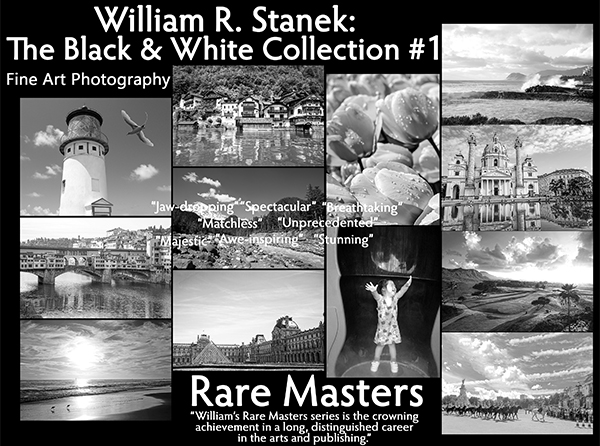
Step into a world of timeless beauty with our premium, oversized hardcover book - crafted for discerning collectors and anyone who values the power of art. Perfect for your coffee table, it's more than just a book; it's a conversation starter, a window into over 30 years of William's visionary photography.
Your Support Matters
Purchasing artwork from William Stanek's collection not only brings beauty into your life but also helps us continue to share. Thank you for supporting our creative journey!
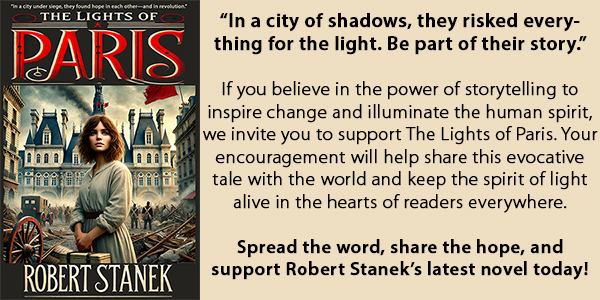
Support The Lights of Paris by Robert Stanek, William Stanek's pen name! Through vivid historical detail and deeply moving character stories, Robert takes readers on an unforgettable journey through one of history’s most transformative times.




